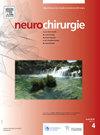酷似脑膜瘤的巨大血栓形成的中脑膜动脉瘤。
IF 1.4
4区 医学
Q4 CLINICAL NEUROLOGY
引用次数: 0
摘要
简介:真正的脑膜中动脉瘤(MMAAs)极为罕见,文献记载的病例少于20例,只有一例纤维发育不良患者被描述为巨型动脉瘤。通常小于10mm,这些病变可能被误认为是其他血管异常,如颅内动脉瘤、动静脉畸形(AVMs)或硬脑膜动静脉瘘(davf)。本报告描述了一种独特的血管病变,它具有四个罕见的特征:(1)真正的MMAA,(2)体积巨大,(3)完全血栓形成,(4)模拟肿瘤(假肿瘤行为)。材料和方法:70岁男性,无颅脑外伤史,癫痫发作后出现右半瘫。影像学显示左侧额顶颞区有一个266cc的轴外肿块,引起明显的中线移位(18mm)和心室压迫。CT和MRI显示病灶边界清晰,增强后可见硬脑膜尾征,怀疑为脑膜瘤。手术切除采用标准脑膜瘤技术。在显微外科解剖和减积过程中,术中病理显示非肿瘤组织。结论:该病例强调了真正的MMAAs模仿其他颅内病变的潜力。由于他们的位置和硬脑膜受累,高度的怀疑是必不可少的。我们建议外科医生在遇到类似症状时,在术前和术中应注意的事项,以避免误诊并指导适当的处理。这些方法包括侵入性成像技术,考虑到缺乏再生的可能性,可接受的病灶次全切除和最佳硬脑膜重建,以避免脑脊液瘘等并发症。本文章由计算机程序翻译,如有差异,请以英文原文为准。
Giant Thrombosed Middle Meningeal Artery Aneurysm Mimicking a Meningioma
Introduction
True middle meningeal artery aneurysms (MMAAs) are extremely rare, with fewer than 20 documented cases and only one previously described as a giant aneurysm in a patient with fibrous dysplasia. Typically measuring under 10 mm, these lesions can be mistaken for other vascular abnormalities such as intracranial aneurysms, arteriovenous malformations (AVMs), or dural arteriovenous fistulas (DAVFs). This report describes a unique vascular lesion combining four rare features: (1) true MMAA, (2) giant in size, (3) completely thrombosed, and (4) mimicking a tumor (pseudotumoral behavior).
Material and methods
A 70-year-old male with no history of cranial trauma presented with right hemiparesis following a seizure. Imaging revealed a 266cc extra-axial mass in the left fronto-parieto-temporal region, causing significant midline shift (18 mm) and ventricular compression. CT and MRI findings showed a well-circumscribed lesion with post-contrast enhancement and a dural tail sign, raising suspicion for a meningioma. Surgical resection was performed using standard meningioma techniques. During microsurgical dissection and debulking, intraoperative pathology revealed non-neoplastic tissue.
Conclusion
This case highlights the potential for true MMAAs to mimic other intracranial pathologies. Due to their location and dural involvement, a high index of suspicion is essential. We recommend specific preoperative and intraoperative considerations for surgeons encountering similar presentations to avoid misdiagnosis and guide appropriate management. These include invasive imaging techniques, acceptable subtotal resection of the lesion given the lack of regrowth possibilities and optimal dural reconstruction to avoid complications such as cerebrospinal fluid fistulae.
求助全文
通过发布文献求助,成功后即可免费获取论文全文。
去求助
来源期刊

Neurochirurgie
医学-临床神经学
CiteScore
2.70
自引率
6.20%
发文量
100
审稿时长
29 days
期刊介绍:
Neurochirurgie publishes articles on treatment, teaching and research, neurosurgery training and the professional aspects of our discipline, and also the history and progress of neurosurgery. It focuses on pathologies of the head, spine and central and peripheral nervous systems and their vascularization. All aspects of the specialty are dealt with: trauma, tumor, degenerative disease, infection, vascular pathology, and radiosurgery, and pediatrics. Transversal studies are also welcome: neuroanatomy, neurophysiology, neurology, neuropediatrics, psychiatry, neuropsychology, physical medicine and neurologic rehabilitation, neuro-anesthesia, neurologic intensive care, neuroradiology, functional exploration, neuropathology, neuro-ophthalmology, otoneurology, maxillofacial surgery, neuro-endocrinology and spine surgery. Technical and methodological aspects are also taken onboard: diagnostic and therapeutic techniques, methods for assessing results, epidemiology, surgical, interventional and radiological techniques, simulations and pathophysiological hypotheses, and educational tools. The editorial board may refuse submissions that fail to meet the journal''s aims and scope; such studies will not be peer-reviewed, and the editor in chief will promptly inform the corresponding author, so as not to delay submission to a more suitable journal.
With a view to attracting an international audience of both readers and writers, Neurochirurgie especially welcomes articles in English, and gives priority to original studies. Other kinds of article - reviews, case reports, technical notes and meta-analyses - are equally published.
Every year, a special edition is dedicated to the topic selected by the French Society of Neurosurgery for its annual report.
 求助内容:
求助内容: 应助结果提醒方式:
应助结果提醒方式:


